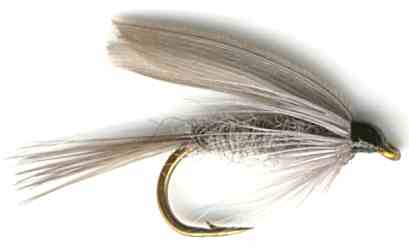The Blue Dun Wet Fly
The Blue Dun Wet Fly has taken many trout for me, particularly early in the season. Trout have a great liking for this little fly.

WET FLY PATTERNS. Hook size 12 14 - $US each
It is commonly believed that The Blue Dun Mayfly hatches only on wet, windy days. This is not true as I have seen numerous hatches in calm warm conditions. It is easy to spot as it is the only upwinged fly that has such an overall dark body color. It hatches during the summer with peaks at the beginning and end of summer. It emergers at the surface in open water during the day in irregular, sometimes prolific, hatches. The Blue Dun generally is not an evening fly. They tend to swarm during the day. Mating and egg laying also often takes place during the day.
WET FLIES
A wet fly is designed to be fished below the water's surface.
They are tied as deceivers or attractors. The success of the wet fly often depends far more on its
action in the water than on its resemblance to a particular insect, but this is
not always the case. When fish are on the feed the actual pattern is generally
not important, but when the fish are preoccupied or need tempting the angler
must use ingenuity to discover what the fish are feeding on and what color they
are taking. When fishing wet flies, it is important to remember that the higher
the wave on the water the higher the fly hook size can be, but still take into
account the brightness and clarity of the water.
Trout do see subsurface insects with wings. Some flies begin to hatch below the water surface. The Baetis group of up-winged flies swim or crawl beneath the surface as adult spinners in order to lay egg. There are occasions when duns and spent spinners are swamped by the current and forced under the water surface. Emerging duns that have been unable to get rid of their nymphal case or at the time of emerging are drowned when they float under rough water that is flowing over a large rock or ledge are also hunted by the fish. The trout on purpose lurk in slack water near eddies and small plunge pools to look out for these type of snacks. Clearly a trout does see winged insects under the surface at certain times of the year so be prepared with a selection of different colored wet flies for when the fish are not taking from the surface.


Fly Fishing books

